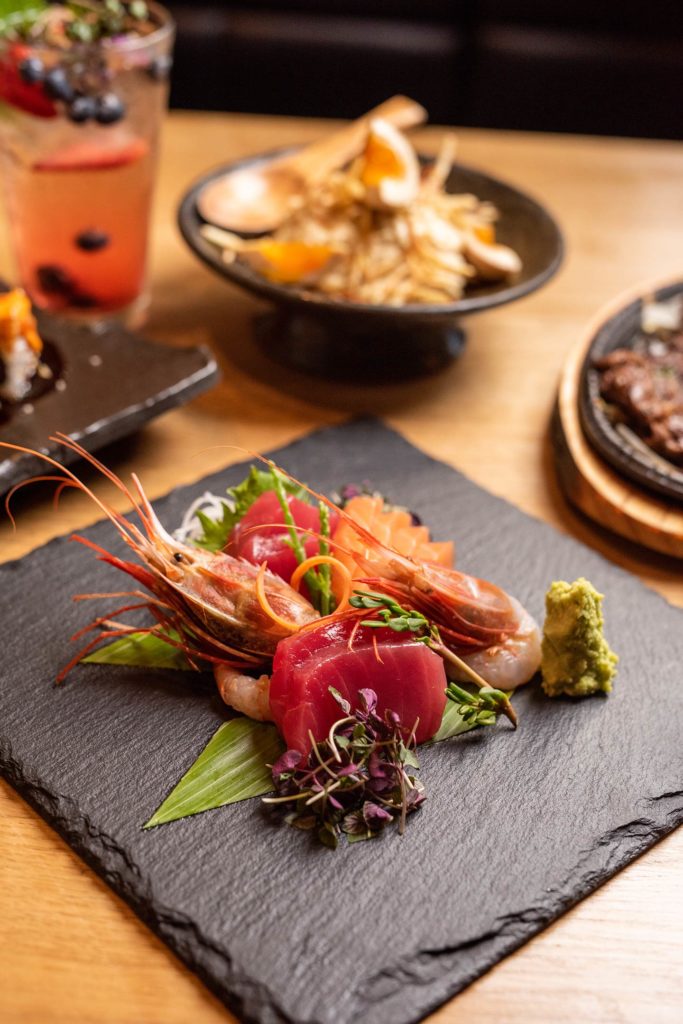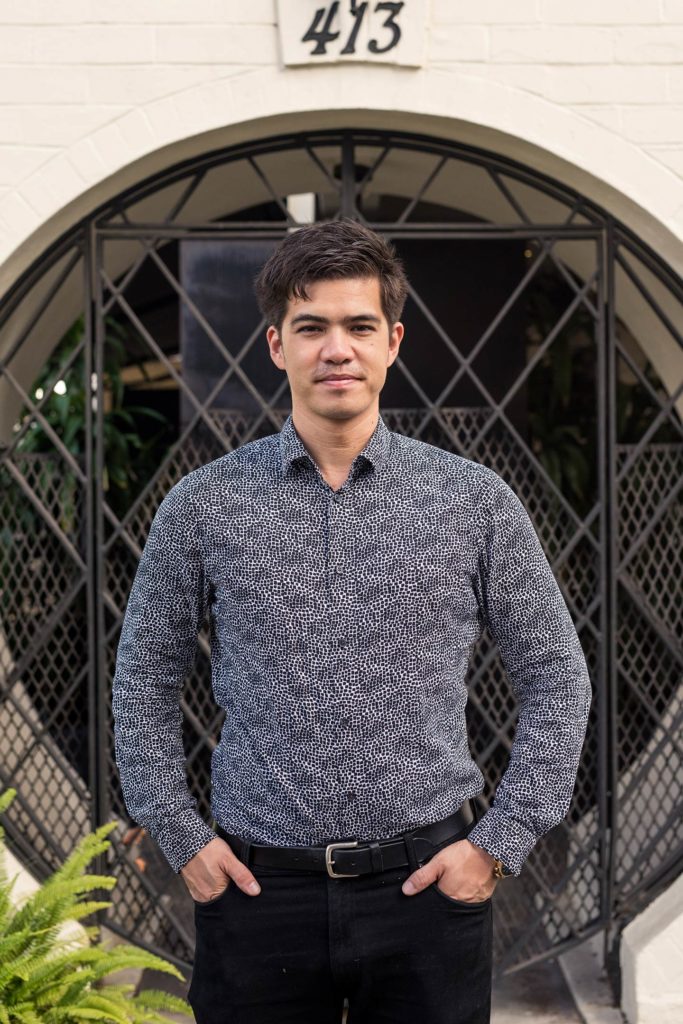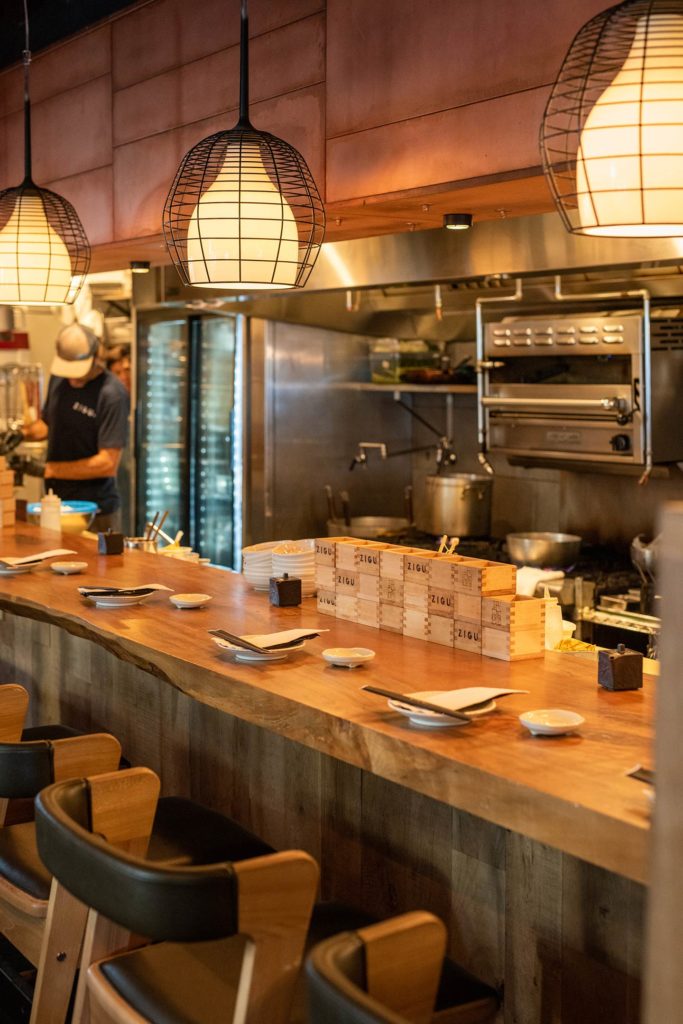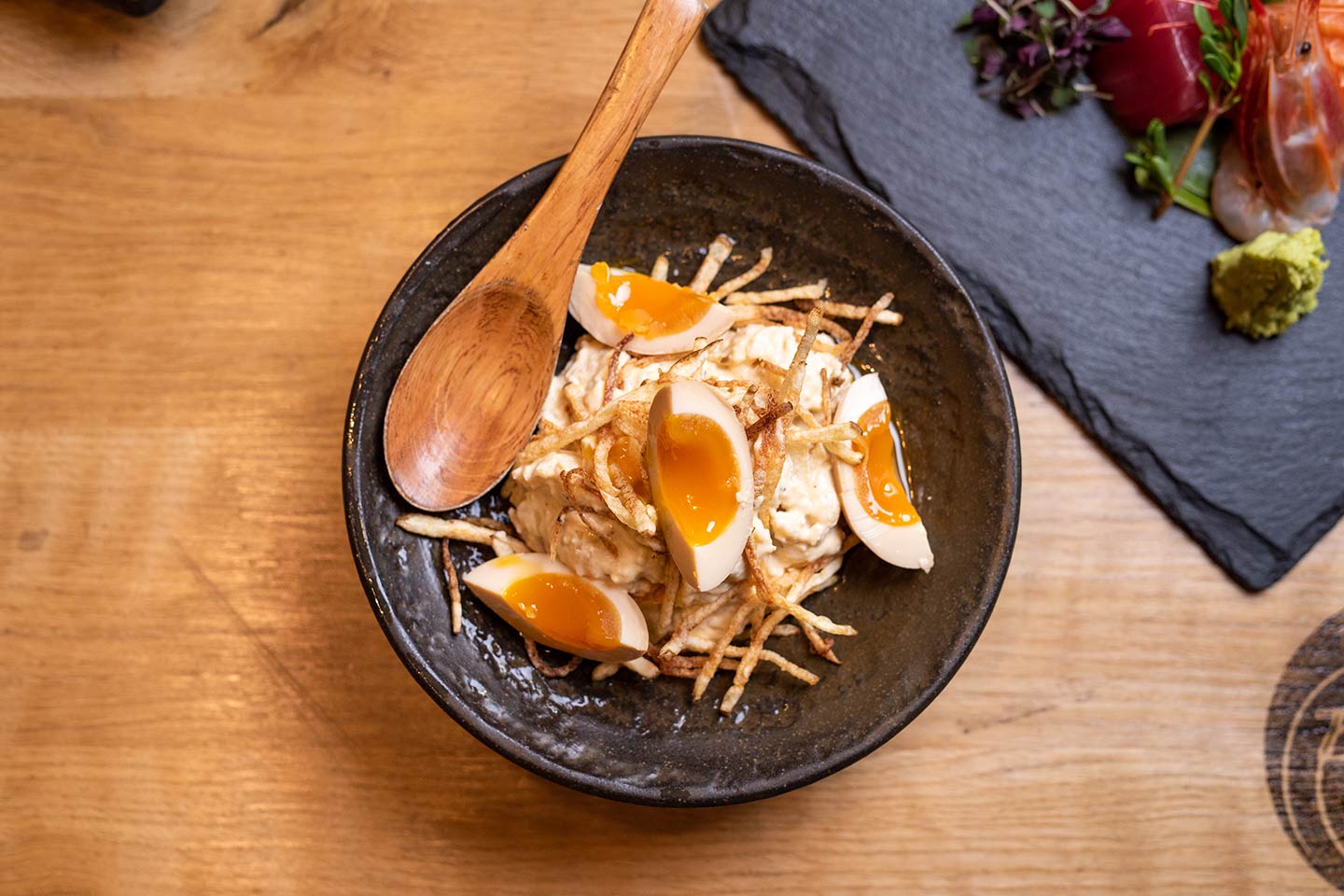Text by Timothy A. Schuler
Images by Chris Rohrer
The late-afternoon sun warmed the wooden bar and made lanterns out of the whiskey bottles that lined its edge. Outside, Waikīkī was winding down. Or winding up. It was hard to say. The sidewalk was a ballet: Deliverymen dodged unwitting tourists while light-footed joggers pirouetted around them. In the kitchen behind the bar, cooks clad in tattoos and denim aprons prepped the evening’s dishes: fresh, local sashimi and cold kale udon with bitter okra and natto.

I’m at Zigu, a Japanese izakaya that feels deep in a love affair with Hawai‘i. Located on Seaside Avenue in Waikīkī, the menu features an abundance of locally sourced fish, pork, yuzu, and other produce, much of it assembled in surprising ways. The restaurant opened in 2018 alongside its more buttoned-up sibling, Paris Hawaii, an island-inspired French concept by chef Yuya Yamanaka, located just upstairs.
Both restaurants are owned by Japanese restaurant group Zetton, which has been honing its brand of local culinary style since 2009, when it opened Aloha Table, a casual eatery a few blocks away that serves everything from corn dogs to oxtail soup in a contemporary Hawaiiana setting.
Zetton’s lineup of restaurants includes Goofy Cafe and Dine, Heavenly, and now Zigu and Paris Hawaii, all of which have laidback vibes and farm-to-table menus, though some of the creations can feel odd, as if something has been lost in translation—Hawai‘i reflected in a disco ball. For instance, Goofy, whose name seems to be a reference to the right-foot-forward surf stance, appears unable to decide if it’s a casual breakfast spot, a coffee shop, or a breezy upstairs dive.

But time and repetition have worked their refining magic. Aesthetically, Zigu and Paris Hawaii are Zetton’s most restrained concepts, with minimalist material palettes of unfinished wood, raw concrete, and ebony steel. Paris Hawaii has pitch-black curtains, raw concrete, and custom details like a herringbone wood floor.
Its interior design is as refined as the luxurious dishes of Yamanaka’s ever-evolving, seven-course, prix fixe menu (think ‘ahi poke topped with beef tartare and coconut). Zigu is equally concerned with ambiance, its restrained furnishings complementing the spartan space.
Much of both restaurants’ appeal comes from the building itself, 413 Seaside Avenue, a two-story walk-up constructed in the late 1930s that has withstood Waikīkī’s evolution from a quiet destination with a smattering of hotels to a dense, urban neighborhood.
Listed on the National Register of Historic Places, the building was designed by Bjarne Dahl and Connie Conrad, a pair of California transplants who were in high demand at the time, and it is a perfect example of Hawai‘i’s architectural fusion: vaguely Mediterranean, slightly Chinese, 100-percent tropical. The scalloped wall that surrounds the lānai is incised by a circular moon gate, borrowed from Chinese architecture, while modern lines and Art Deco motifs reveal European influence. Despite this hodgepodge, the design still manages to feel subtle, exuding a stylish simplicity.
History is short in Waikīkī, and often for sale, but 413 Seaside is part of a countertrend that embraces historic preservation as a way to prevent Waikīkī’s character from being completely lost.
In renovating the interiors, Naoto Adachi, of Tokyo-based architectural design studio Garment, allowed the building’s original elements to shine. He retained the original windows, tile floors, and decorative metalwork around the lānai, which twists and spins into ferns and other floral patterns. The space was kept raw and unassuming, which, if not exactly innovative, is a rarity in Waikīkī, a scene that tends to abhor austerity.
Preserving the historic structure was of particular interest to its owner, Mark Smith, whose grandparents developed 413 Seaside Avenue more than 80 years ago. Smith’s grandfather, Francis Cooper, was the youngest child of Henry E. Cooper, a prominent attorney who helped overthrow the Hawaiian monarchy in 1893 and briefly served as the attorney general of the Republic of Hawai‘i.
The Coopers were allies of sugar plantation owners like Sanford Dole, and Francis eventually got into sugar himself, moving his family to the island of Negros in the Philippines, where he operated three plantations and some of the country’s first movie theaters. When Cooper returned to Hawai‘i in 1936, he started a transportation and construction company in what is now Kaka‘ako.
The company produced the concrete masonry blocks that workers stacked to make the walls of 413 Seaside Avenue, as well as the unique, red-tinted, hollow concrete tile that still adorns the building’s roof, a product that Cooper developed.

Smith, who grew up in Salem, Oregon, remembers 413 Seaside well. In the summers, he visited his grandmother Hazel Cooper, who managed the apartment building and the Cooper Apartments next door, which the family also built. Most summers, Smith stayed with his grandmother, but one year, while he was in college, he secured a studio in 413 Seaside.
“That was a magical summer for me,” he says. “I was a big Charles Dickens fan. I read and reread Dombey and Son, Great Expectations, The Life and Adventures of Nicholas Nickleby. I was a runner, so I’d run, read Dickens, work, and study Japanese.”
The building was eventually converted into commercial space, but Smith, who moved to Hawai‘i full time in 2006 and oversees the property alongside his family, felt that 413 Seaside, and especially its spacious lānai, had gone underused. When Zetton approached Smith about opening a pair of restaurants there, Smith saw it as an opportunity to realize the building’s potential. After years of renovation, 413 Seaside reopened to the public in 2018, its clean, white masonry walls and deep eaves cutting a newly handsome profile.
History is short in Waikīkī, and often for sale, but 413 Seaside is part of a countertrend that embraces historic preservation as a way to prevent Waikīkī’s character from being completely lost. It joins a growing roster of exciting and thoughtful rehabilitations, including the newly opened White Sands Hotel, redeveloped by the same group as The Surfjack Hotel and Swim Club on Lewers Street.
Mark Rogers, Zigu’s general manager, says part of Zetton’s mission is to contribute to the character, creativity, and long-term prosperity of Waikīkī. “We should leave some of Hawai‘i’s old construction,” he says. If not, he says, Waikīkī becomes like anywhere else in the world.
With the group’s focus on French, Japanese, and Hawaiian cuisines, served in spaces that marry early modern architecture with Japanese minimalism, Zetton’s newest restaurants could not exist anywhere but Hawai‘i. And with so much creativity on display, no single dish, style, or element steals the show. The restaurants at 413 Seaside Avenue are an ensemble performance, and Waikīkī is richer for it.





